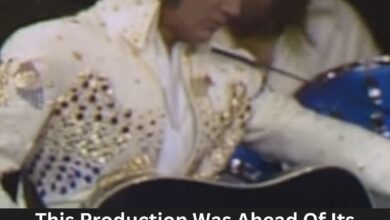Rediscovering Elvis after years, the first song my dad played for me when I was a young girl
“Green, Green Grass of Home” is one of Elvis Presley’s notable musical masterpieces that has left an indelible mark on the world of music. This captivating song, released in 1967, showcases Elvis’s unmatched vocal prowess and emotive delivery. The song’s narrative weaves a poignant tale of longing and nostalgia, evoking a powerful sense of homesickness and the yearning for familiar surroundings. The lyrics depict a man reflecting on his life, reminiscing about his home, family, and the simpler joys of life he left behind, which resonates with many listeners who have experienced similar feelings of longing.
In this iconic track, Elvis’s rich and resonant voice is perfectly complemented by the lush orchestration and soulful melodies. The sound of the song effortlessly fuses country and pop elements, creating a distinctive sound that feels both timeless and contemporary for its era. The blending of these genres highlights Elvis’s versatility as a performer and allows the song to transcend generational boundaries, finding a place in the hearts of fans across ages. This skillful combination of musical styles makes the song appealing to a wide audience, further solidifying its place in the annals of music history.
The arrangement of “Green, Green Grass of Home” stands out due to its thoughtful instrumentation, where strings, brass, and rhythm enhance the emotional weight of the lyrics. Every note and chord complements Elvis’s vocal delivery, emphasizing the themes of longing and regret. The song’s powerful crescendo mirrors the emotional highs and lows experienced by the narrator, making the listening experience incredibly immersive.
Moreover, Elvis’s performance captures the essence of the song’s narrative on a visceral level. His ability to convey deep emotion through his singing—marked by his characteristic phrasing and dynamic range—adds a poignant touch to the story being told. Listeners can feel the yearning in his voice as he dreams of returning to the green grass of home, a metaphorical representation of comfort and belonging. This connection between the singer and the audience is a hallmark of Elvis’s artistry and is key to the song’s widespread appeal.
The video that accompanies “Green, Green Grass of Home” further enhances the emotional impact of the song, featuring evocative visuals that mirror its themes of reminiscence and longing. Cinematic imagery, including shots of rolling hills, expansive fields, and nostalgic homesteads, invites viewers to visualize the homecoming that the lyrics describe. As Elvis serenades with his heartfelt rendition, the imagery deepens the emotional immersion, transporting viewers to a place filled with bittersweet memories.
This song is not merely a romantic ballad; it addresses universal themes of love, loss, and the passage of time. People often find themselves reflecting on their own personal experiences when they listen to “Green, Green Grass of Home.” The song acts as a vessel for collective memory, where individuals can map their own feelings of nostalgia onto the singer’s journey, thereby enhancing its emotional resonance and lasting impact.
“Green, Green Grass of Home” stands as a testament to Elvis Presley’s enduring musical legacy. The song showcases his ability to touch hearts and minds through exceptional vocal talent and compelling storytelling. It encapsulates the struggles of the human experience, specifically our innate desire to return to the places and people we hold dear.
Elvis’s influence on music and culture is immense, and this song is an integral part of that legacy. His unique blend of rock, pop, country, and gospel elements revolutionized the music industry and paved the way for countless artists who followed. By interpreting songs like “Green, Green Grass of Home” with such depth, Elvis helped elevate the genre and provided a model of emotional authenticity that many artists strive for today.
In addition to its impact on music, the song has been covered by numerous artists over the years, each interpreting the lyrics through their own stylistic lens. This speaks to the song’s powerful songwriting and the universality of its themes. The song’s adaptability allows it to be continuously reimagined while still retaining its original emotional core.
Ultimately, “Green, Green Grass of Home” is more than just a song; it is a cultural artifact that invites reflection and connection. With each listen, audiences can engage in a shared experience of memory and longing, making it a timeless classic that will continue to resonate for generations to come.



